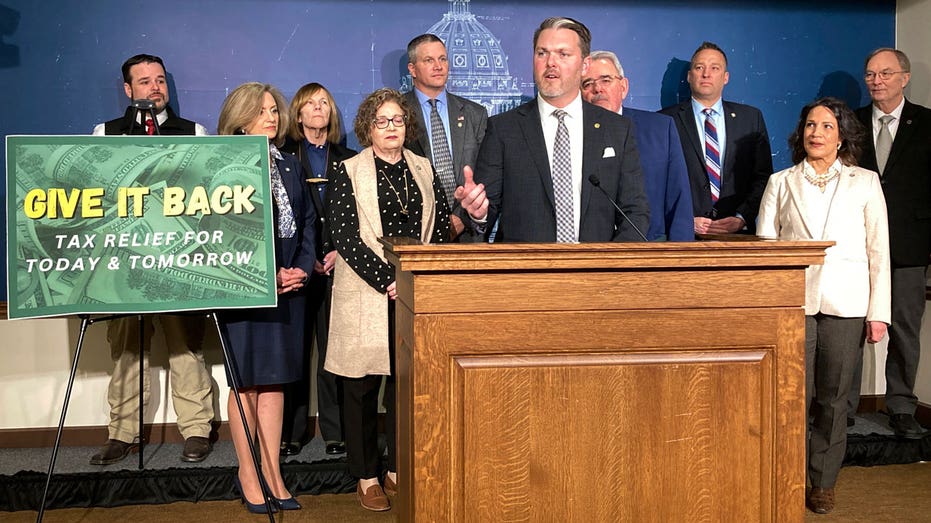Calls for eliminating Minnesota income taxes on Social Security income are coming not just from Republicans, but some Democrats as well, and it’s shaping up as one of the biggest issues of the 2023 legislative session.
The GOP minority in the Minnesota Senate is threatening to hold up a public infrastructure package that passed the House on Monday unless it gets some kind of tax relief from the state’s enormous $17.5 billion budget surplus. The tax on Social Security is a popular candidate for cutting. Several top Democratic leaders, who would rather target tax cuts to needier Minnesotans, are coming under pressure to compromise.
Minnesota is one of 11 states that tax Social Security income to some degree. But many Minnesota seniors already are fully or partially exempt, and eliminating the taxation could have big costs down the road. Here is a look at the complex issues in the debate:
US SOCIAL SECURITY BENEFITS AT RISK IN 10 YEARS DUE TO FUNDING SHORTAGE: MAYA MACGUINEAS
Why Does Minnesota Tax Social Security?
Social Security income is already partially exempt at the federal and state levels, and it’s fully exempt at the lowest income levels. The idea is that taxpayers with the same incomes should pay the same tax no matter the source of the income. Minnesota’s tax code is designed to spare lower-income recipients who are most dependent on the monthly checks, while keeping Social Security taxable for well-off residents who have other sources of income. More than 50% of Minnesota households receiving Social Security pay no state taxes on their benefits.
Who Has to Pay the Tax in Minnesota
In general, Minnesota residents with federal adjusted gross incomes above $75,000 pay the highest taxes on Social Security. According to the nonpartisan Minnesota House ResearchDepartment, when non-filers are counted, only about a third of all Social Security benefits paid to Minnesota residents are subject to state income tax. But around 370,000 filers paid at least some state tax on their Social Security in 2019. That worked out to about 62% of all returns from residents that listed Social Security income.
Why is It So Complicated?
Figuring out how much of one’s Social Security income is currently taxable — or will be in one’s future retirement — isn’t simple. Short of sitting down and running your tax calculations, or consulting a professional preparer, taxpayers can get a rough idea for various scenarios from an online tool developed by House Research.
Who pays and how much isn’t neat and simple because two different tax policies result in Social Security being exempt. One is a federal exclusion from gross income for a portion of the benefits. The other is a Minnesota-specific subtraction for a portion of Social Security income that’s subject to federal tax. They interact with other sources of income, and the effects aren’t necessarily clear on returns.
“It is hard for folks to understand, I think, which of their Social Security is taxable and which is exempt, and I think that probably contributes to folks maybe thinking they are paying more for taxes on their Social Security than they actually do,” said Nan Madden, director of the Minnesota Budget Project, an initiative of the Minnesota Council of Nonprofits.
Why Not Just Eliminate the Tax?
Complete elimination was a popular theme for GOP candidates in 2022, and as well as some Democrats in swing districts that were key to Democrats winning the trifecta of the House, Senate and governor’s office. The growth in the state’s projected budget surplus to an enormous $17.5 billion has only fueled the calls for permanent tax relief.
GOP leaders like to frame elimination as relief for seniors who are struggling with soaring inflation, even if the ones struggling the most are the least likely to be taxed on Social Security. They also say it would make Minnesota more competitive with other states as a place to retire, slowing the migration to the Sunbelt and neighboring states that don’t tax Social Security..
Madden and other critics of elimination point out that it would be expensive, costing the state $604 million in lost revenue in fiscal 2024, according to estimates from the Minnesota Department of Revenue, rising to $777 million in 2027, and continuing to increase. That’s money that could otherwise go to schools, health care, housing and other services, many of which benefit seniors.
According to the Minnesota Budget Project, more than half of the tax savings would go to households with incomes over $143,000 — the highest 20% — who would get annual tax savings averaging more than $2,000. Relatively little relief, if any, would go to households with incomes of $60,000 or less — the bottom 40%.
MINNESOTA REPUBLICANS PROPOSE $13B TAX CUT
What Specifics Are on the Table?
Democratic Gov. Tim Walz has proposed expanding the exemptions without eliminating them altogether, a move that would benefit around 376,000 filers with an average tax cut of $281. But he opposes complete elimination, saying the wealthy will do fine without it.
With the pressure building, the House tax committee on Thursday will hear a pair of bills authored by Democrats — one to fully eliminate the tax and another to exempt more Minnesota seniors. The Senate tax panel took a first look at a similar Democratic elimination plan in January but made no decisions.
The outcome is likely to come down to intense negotiations in the coming weeks as the Legislature tries to complete work on a two-year budget before adjourning in May.
























